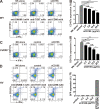Tumor-derived soluble CD155 inhibits DNAM-1-mediated antitumor activity of natural killer cells
- PMID: 32040157
- PMCID: PMC7144518
- DOI: 10.1084/jem.20191290
Tumor-derived soluble CD155 inhibits DNAM-1-mediated antitumor activity of natural killer cells
Abstract
CD155 is a ligand for DNAM-1, TIGIT, and CD96 and is involved in tumor immune responses. Unlike mouse cells, human cells express both membranous CD155 and soluble CD155 (sCD155) encoded by splicing isoforms of CD155. However, the role of sCD155 in tumor immunity remains unclear. Here, we show that, after intravenous injection with sCD155-producing B16/BL6 melanoma, the numbers of tumor colonies in wild-type (WT), TIGIT knock-out (KO), or CD96 KO mice, but not DNAM-1 KO mice, were greater than after injection with parental B16/BL6 melanoma. NK cell depletion canceled the difference in the numbers of tumor colonies in WT mice. In vitro assays showed that sCD155 interfered with DNAM-1-mediated NK cell degranulation. In addition, DNAM-1 had greater affinity than TIGIT and CD96 for sCD155, suggesting that sCD155 bound preferentially to DNAM-1. Together, these results demonstrate that sCD155 inhibits DNAM-1-mediated cytotoxic activity of NK cells, thus promoting the lung colonization of B16/BL6 melanoma.
© 2020 Okumura et al.
Conflict of interest statement
Disclosures: The authors declare no competing interests exist.
Figures







Similar articles
-
Essential role of CD155 glycosylation in functional binding to DNAM-1 on natural killer cells.Int Immunol. 2024 Apr 27;36(6):317-325. doi: 10.1093/intimm/dxae005. Int Immunol. 2024. PMID: 38289706
-
DNAM-1/CD155 interactions promote cytokine and NK cell-mediated suppression of poorly immunogenic melanoma metastases.J Immunol. 2010 Jan 15;184(2):902-11. doi: 10.4049/jimmunol.0903225. Epub 2009 Dec 11. J Immunol. 2010. PMID: 20008292
-
Laquinimod, a prototypic quinoline-3-carboxamide and aryl hydrocarbon receptor agonist, utilizes a CD155-mediated natural killer/dendritic cell interaction to suppress CNS autoimmunity.J Neuroinflammation. 2019 Feb 26;16(1):49. doi: 10.1186/s12974-019-1437-0. J Neuroinflammation. 2019. PMID: 30808363 Free PMC article.
-
CD155 immunoregulation as a target for natural killer cell immunotherapy in glioblastoma.J Hematol Oncol. 2020 Jun 12;13(1):76. doi: 10.1186/s13045-020-00913-2. J Hematol Oncol. 2020. PMID: 32532329 Free PMC article. Review.
-
DNAM-1 versus TIGIT: competitive roles in tumor immunity and inflammatory responses.Int Immunol. 2021 Nov 25;33(12):687-692. doi: 10.1093/intimm/dxab085. Int Immunol. 2021. PMID: 34694361 Review.
Cited by
-
Specific Patterns of Blood ILCs in Metastatic Melanoma Patients and Their Modulations in Response to Immunotherapy.Cancers (Basel). 2021 Mar 22;13(6):1446. doi: 10.3390/cancers13061446. Cancers (Basel). 2021. PMID: 33810032 Free PMC article.
-
Involvement of the glymphatic/meningeal lymphatic system in Alzheimer's disease: insights into proteostasis and future directions.Cell Mol Life Sci. 2024 Apr 23;81(1):192. doi: 10.1007/s00018-024-05225-z. Cell Mol Life Sci. 2024. PMID: 38652179 Free PMC article. Review.
-
Expression of Membranous CD155 Is Associated with Aggressive Phenotypes and a Poor Prognosis in Patients with Bladder Cancer.Cancers (Basel). 2022 Mar 19;14(6):1576. doi: 10.3390/cancers14061576. Cancers (Basel). 2022. PMID: 35326727 Free PMC article.
-
Role of Long Non-Coding RNA GUSBP11 in Chronic Periodontitis Through Regulation of miR-185-5p: A Retrospective Cohort Study.J Inflamm Res. 2025 Jan 16;18:655-665. doi: 10.2147/JIR.S496143. eCollection 2025. J Inflamm Res. 2025. PMID: 39835295 Free PMC article.
-
Alzheimer's disease: insights into pathology, molecular mechanisms, and therapy.Protein Cell. 2025 Feb 1;16(2):83-120. doi: 10.1093/procel/pwae026. Protein Cell. 2025. PMID: 38733347 Free PMC article. Review.
References
-
- Bevelacqua V., Bevelacqua Y., Candido S., Skarmoutsou E., Amoroso A., Guarneri C., Strazzanti A., Gangemi P., Mazzarino M.C., D’Amico F., et al. . 2012. Nectin like-5 overexpression correlates with the malignant phenotype in cutaneous melanoma. Oncotarget. 3:882–892. 10.18632/oncotarget.594 - DOI - PMC - PubMed
-
- Blake S.J., Stannard K., Liu J., Allen S., Yong M.C., Mittal D., Aguilera A.R., Miles J.J., Lutzky V.P., de Andrade L.F., et al. . 2016. Suppression of metastases using a new lymphocyte checkpoint target for cancer immunotherapy. Cancer Discov. 6:446–459. 10.1158/2159-8290.CD-15-0944 - DOI - PubMed
-
- Bottino C., Castriconi R., Pende D., Rivera P., Nanni M., Carnemolla B., Cantoni C., Grassi J., Marcenaro S., Reymond N., et al. . 2003. Identification of PVR (CD155) and Nectin-2 (CD112) as cell surface ligands for the human DNAM-1 (CD226) activating molecule. J. Exp. Med. 198:557–567. 10.1084/jem.20030788 - DOI - PMC - PubMed
Publication types
MeSH terms
Substances
LinkOut - more resources
Full Text Sources
Molecular Biology Databases
Research Materials

